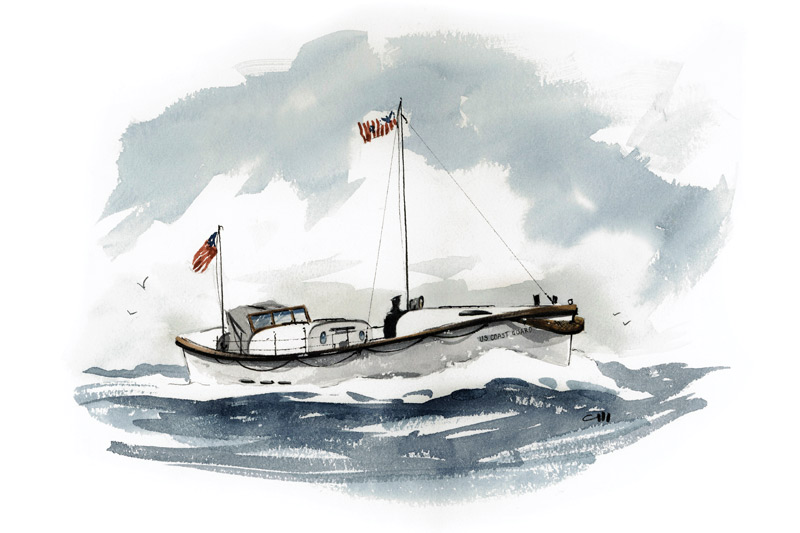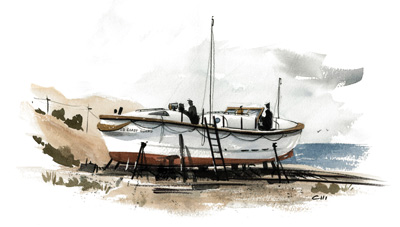
U.S. Coast Guard Motor Lifeboat lives again.
 The Port of Astoria’s haul-out yard may not sound like a great place to go looking for boating stories, but there is always a wide variety of working boats and yachts on the hard and the chance there might be a story worth re-telling. For the 15 years I have lived in the area, the most unusual and interesting craft I have ever encountered is the 36-foot US Coast Guard motor lifeboat (MLB), built in 1934 and recently found, rebuilt, and fully restored between 2005 and 2012.
The Port of Astoria’s haul-out yard may not sound like a great place to go looking for boating stories, but there is always a wide variety of working boats and yachts on the hard and the chance there might be a story worth re-telling. For the 15 years I have lived in the area, the most unusual and interesting craft I have ever encountered is the 36-foot US Coast Guard motor lifeboat (MLB), built in 1934 and recently found, rebuilt, and fully restored between 2005 and 2012.
I first met Glen Cathers, the owner of “MLB 36391,” in the summer of 2013 and introduced myself with the hope of learning enough to write a story. Glen was happy to talk about the project; he briefly recounted the historical connections that he had with the Coast Guard in general and this class of boat in particular, and generously invited me up on deck for a tour. It was clearly an enormous job for one man to undertake, and I realized this was a once-in-a-lifetime opportunity to learn more about a time and a boat that were rapidly fading into the past. Standing in the small cockpit, I asked him how this amazing project came together.
“I had fallen in love with the motor lifeboat when I was 10 years old,” he recalled. “That was when my father, John L. Cathers, was officer in charge at the Point Adams Station (downriver from Astoria) during the 1940s and 1950s, retiring as a master Chief Boatswain’s Mate in 1962. He often took me out in the station’s MLB; and I can still remember riding in the ‘glory hole’ (foredeck hatch) up in the bow. When they stuck the boat into a wave and the spray broke clean over me, I was smitten from that day on!”
Glen served in the Coast Guard on the East Coast in 1959-63, so he never crewed a MLB on the Pacific Coast where the boat had done such vital work. But he moved back to the Northwest when he retired from a career working on the ferries in New York Harbor and soon started looking for a retirement project—preferably a historic boat of some kind. When his wife, Naomi Fisher, asked him what kind of boat he would choose if he could have anything, he replied without hesitation: “I want a motor lifeboat.”
“Let’s do it,” she said.
The first break came when a friend happened to be driving through Seattle and glimpsed an old MLB 36 on Lake Union. “I drove straight up to see it and found it was really rotten, but had some parts and a GM 4-71 engine I could salvage,” said Glen. He trucked it back to his home in Goldendale, Washington overlooking the Columbia River Gorge, and began salvaging whatever he thought was worth saving from this near-derelict hull.
But a month later, they found a second MLB 36 in Astoria. “I could see that bronze bullnose on it. I knew right then it was the real deal, even though the interior had been completely gutted and replaced with one big cabin,” Glen told me. That boat was built in 1934 and was hardly recognizable as an MLB. It was also in a very poor state, but they purchased it anyway and began the restoration that would fill most of his time for the next six to seven years.
So you can imagine the surprise and the thrill that he experienced when he was stripping off all the old layers of paint and discovered the original boat number was 36391. “I researched where the boat with that number came from, and lo and behold I discovered it had spent its career at Point Adams at the mouth of the Columbia. It was the very boat I had been on as a boy, and it was used on numerous rescue missions for 22 years. To further my amazement, my aunt gave me two pictures of my father and my uncle on the very same boat.”
After the 60-odd years that had passed since his first ride, Glen finally began learning the details of the history and construction of this class. Sadly, the remaining hulls had all been relegated to the status of nautical sculptures at the entrance to some Coast Guard stations on the Northwest coast (there is also one inside the Columbia River Maritime Museum in Astoria). There was only one MLB 36 remaining in operating condition — the famous 36500 maintained by the Orleans Historical Society in Cape Cod, Massachusetts.

Glen re-planked the hull above the waterline with 1¼” yellow Alaskan cedar, and doubled all the frames with steamed oak timbers. Then he and Naomi riveted over 5,000 nails and roves to make the hull as strong and tight as it has ever been.
Next, he carefully reestablished the original layout by building the six wooden water-tight bulkheads from planks, and recreated the original layout with three separate compartments: the foc’sle (called the survivor’s cabin) with two single benches (that they now use as bunks), the center house over the engine room, and the helm station.
“It’s all new from the waterline up,” Glen declared. But with most of the bronze hardware that was an essential and distinctive part of the boat missing, Glen had to scour the country looking for parts. Piece by piece, like a jigsaw puzzle, they came into his possession. He has a story about every single item and its function when it was the pride of the Coast Guard crew.
With the thousands of hours spent on the rebuild, I expected Glen would want to keep the boat on the calm waters of the Columbia River and well away from the notorious bar, but I had completely underestimated his passion for this classic. He was intent on running the boat south down the Oregon coast to visit all the Coast Guard stations that depended on this class of lifeboat for surf and offshore rescues for 60 years.
A short history of the
MLB 36391 by Glen Cathers
This boat is very fortunate, as the vast majority of these vessels, long the backbone of the Coast Guard rescue service, were just hauled up on the beach, stripped, and burned when their working life was at an end. (They were replaced by the new steel 44-footers beginning in 1963). She was built at Curtis Bay, Maryland in 1934 — one of approximately 228 built between 1929 and 1954 — and was operated with a crew of three: the coxswain, an engine man, and a seaman, all working within inches of each other.
She is a TR model, 36’ 8” long with a 10’ 6” beam and 3.5′ draft. She is self-bailing and self-righting thanks to a 2,000-pound bronze keel. She had retained the original Sterling petrol engine, while the vast majority of the class were re-powered with 4-71 Detroit diesels after WWII. She was sold out of service in the late 1950s and probably used as a commercial fish boat for many years. When I found her in 2005 for sale at the Port of Astoria boatyard, she was almost unrecognizable as a motor lifeboat except for the bronze bullnose on the stemhead and canoe-sterned hull.
I believe the only thing that saved this vessel is that it had been kept afloat for all those years. Unfortunately, all six watertight bulkheads, the engine room, lazarette, side decks, well deck, and cockpit had all been removed and replaced with one huge cabin. But I thought the hull could be restored, so we purchased the boat and brought it home, put a roof over it. So began six years of joy and frustration as we brought it back to life.
I researched the TR model, finding drawings, visiting static displays, taking pictures, and talking with many people with an interest in these boats. Many of them have donated or sold us parts and fittings of other MLBs over the years. As a result, this boat ultimately is a fusion of at least 11 different motor lifeboats. I could not have completed this restoration without their contributions from all over the USA.

With the MLB back in the water with a new coat of anti-fouling paint, Glen was intent on giving it a good trial before setting out. It wasn’t long before a retired Coast Guardsman who had served on the same class of MLB heard about the project and caught up with him. When they went out for a ride, Glen invited me to come on board. We headed upriver and spent the next two hours exploring behind Tongue Point around the WW II piers as the Jimmy diesel chugged contentedly away at 1,100 rpm.
It was a rare opportunity for me to experience this iconic vessel underway, and I soon became another member of the MLB 36 fan club! In August 2013, I saw the boat again moored at the downtown dock in Astoria. I found Glen and Naomi on board and relaxing after achieving their goal of visiting the Coast Guard stations in Garibaldi, Depoe Bay, Newport, and Florence.
“We were given a great reception by the Coast Guard and local people and were the center of attention when we moored at the station or the public dock,” they told me. They estimated about 500 people got a close look at the boat, and over 100 came on board.
“We were in big 8- to 12-foot seas off Cape Meares on our way back, so I decided to open the motor out and give her a chance to run with the weather,” Glen recalled. “I increased the speed to 8 knots and we were soon flying over the waves with no hesitation. The motion is quick but not harsh, and we always felt very secure. The boat has performed perfectly in some tough conditions,” he said with pride.
“They were designed to be self-righting when rolled upside down and self-bailing as well. Plenty of crews were ejected from them, and the boats would roll onto the beach with the engine still running,” he pointed out. It’s worth noting that the three crewmen did not have safety straps, in contrast to modern rescue boats. It was only appropriate that Glen and his boat should be the main attraction at the Veteran Lifeboatmen’s Reunion, hosted by Cape Disappointment Station on the first weekend in August 2013. After a couple of years cruising the Columbia, Glen crossed the bar again in 2016 for a second trip along the Oregon coast as far as south as Bandon. But this time he also went north to Neah Bay on the northwest tip of Washington, visiting more Coast Guard stations. “We visited 14 or 15 stations over the summer and the crews were good hosts,” he recalled.
This historic vessel was always well received wherever they stopped in marinas and public docks. After an ambitious four-month cruise, they returned upriver through the locks at the Bonneville and The Dalles dams. They came downriver again in 2017, and I met up with Glen at the Cathlamet Wooden Boat Festival on the Washington shore east of Astoria early in August 2017.

He reckoned the boat now has almost 2,000 nautical miles under her keel in her third incarnation. “This boat was built for 20-year-olds. It’s hard on you physically and I’m now 75,” he admitted. I noticed how it now had the name Point Adams. That is because you need a name, not just a number, for a boat in Washington. “We chose that name to honor the boat’s service to the Point Adams station in Hammond.” Glen and Naomi have brought the boat back home to Goldendale after a thwarted attempt to appear at the Port Townsend Wooden Boat Festival. They are now settling in for the fall.


